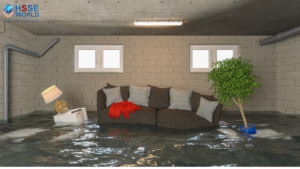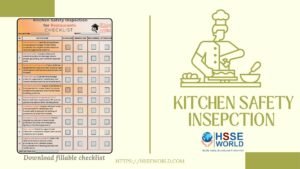Photo of the day: Chemical Spill Emergency Response
Accidental release of chemicals can occur on campus at any time. A chemical release can result in either exposure to a person or as a spill contaminating work areas or the environment. There is a potential for the development of harmful effects depending on the chemical involved and the associated hazards.
The Photo of today provides general guidance for response to chemical exposure or a spill, however; if in doubt, STOP and call the emergency contact number.

Chemical Exposure to a Person
- Remove a person from exposure, if you can safely do so. Avoid breathing the vapors of spilled substances.
- Alert people in the immediate area to evacuate.
- Call emergency contact numbers immediately and request emergency and medical responders.
- Provide as much information known about the incident including specific location, nature, and extent of injuries, name, and quantity of chemicals involved, any control measures are taken, and possible health hazards associated with the spill.
- Provide your name and phone number and remain available.
- Use eyewash or safety showers (in an area away from the spill) to rinse chemicals off the contaminated person.
- For exposure affecting small portions of the skin, immediately flush with flowing water for at least 15 minutes. If pain returns after 15 minutes of flushing, resume flushing the area.
- For splashes in the eye, use eyewash and immediately flush for 15 minutes. Hold the eyelids away from the eyeball, moving the eye in all directions to wash thoroughly behind the eyelids.
- For spills on clothes, quickly begin showering while removing all contaminated clothing, shoes, and jewelry. It may be necessary to cut clothes off in some instances to prevent contamination of the eyes. Contaminated clothes should be discarded or laundered separately from other clothing.
- Consult the chemical safety data sheet (SDS) for any potential delayed effects. Keep the SDS with the victim.
- Obtain medical evaluation and necessary treatment, if needed.
- All injuries of this type must be reported properly.
Chemical Spill Response
Categories of Chemical Spills
The chart below is for liquid spills and the additional information below the chart will help determine the appropriate response to a chemical spill; however, it should not be taken as absolute, as some substances will be considerably more hazardous. Each spill should be judged individually for appropriate action.
| Category | Size | Response | Treatment Materials |
| Small | Less 50 ml | Absorption or Chemical Treatment | Paper towels (if compatible), appropriate absorption spill kit, and/or neutralization |
| Small to Medium | 50 ml to 250 ml | Absorption or Chemical Treatment | Appropriate absorption spill kit and/or neutralization |
| Medium to Large | 250 ml to 2.5 liters | Absorption | Appropriate absorption spill kit |
| Large | More than 2.5 liters | Evacuate and Call 911 | Appropriate absorption spill kit and consider outside help to ensure nothing can enter stormwater drains. |
In addition to this chart, there are three basic categories of chemical spills or release events. The following information should be used as guidance in the event of these types of spills.
1. Spills/Releases That Are Immediately Dangerous to Life or Health (IDLH):
A spill/release that, in the opinion of the area supervisor or individual responsible for the chemical or area, poses an immediate health threat to the individual and/or other occupants in the building. In this case, the following must be done:
- Sound the fire alarm to notify others in the area for evacuation.
- Call 911 from a safe location and provide the following information to the dispatcher:
- Nature of emergency.
- Chemical involved and quantity.
- NMSU building name and room number or nearest building location if outdoors.
- If calling from a cell phone, report location as NMSU campus.
- Remain on the scene to meet response personnel and provide additional information.
2. Spills/Releases That Are Not IDLH But Require Technical Assistance:
This refers to a spill/release that an individual and/or a supervisor feel there is not an immediate health threat but requires technical assistance for proper clean-up. In the event any of the following statements are a factor, contact EHS&RM at (575) 646-3327 or after hours, contact the NMSU Police Department at (575) 646-3311.
- The individual is not familiar with the hazards of the material and not comfortable performing clean-up.
- The individual does not have the proper training to perform clean-up.
- Equipment needed for clean-up is not available.
3. Spill/Releases That Can Be Cleaned Up By Area Personnel:
This refers to a spill/release that an individual and/or a supervisor feel that there is not an immediate health threat and safe for work area personnel to clean-up. Guidelines include the following:
- The individual is thoroughly familiar with the hazards of the material. (Reference SDS)
- The individual has been trained to deal with spills/releases of the size in question.
- The individual has the proper Personal Protective Equipment (PPE) needed for spill clean-up.
- The appropriate absorbent/neutralizers are readily available.
- Take appropriate steps to confine and limit the spill without risk.
- Clean-up spill using appropriate equipment and procedures.
- It is essential that all spill clean-up waste is properly disposed of:
- Do not place in or around the regular trash.
- Place the spill clean-up waste in a closed container and attach an NMSU Waste/Material Tracking Form or a label with contents.
- Contact EH&S for waste pick-up.
Preparation
Hazardous chemical spills must be dealt with promptly, however, due to the range and quantities of chemicals used within laboratories and shops of NMSU, spill response procedures must be clearly defined before work commences. Knowledge and preparedness can minimize potential problems and enhance personnel’s ability to deal with routine spills effectively. Personnel should be instructed on the following in the event of a spill:
- Location and knowledge of the Safety Data Sheets (SDS) for the chemicals used and stored in the work area.
- The location of emergency equipment (fire extinguishers, safety shower, and eyewash).
- The location of appropriate personal protective equipment and spill control equipment (see below for Spill Kit contents).
- The location of available exits.
- The location and content of department Chemical Hygiene Plan (applicable to laboratories).
- When and who a spill shall be reported to.
- Name and phone number of individual responsible for the work area.
Spill Material Kits
EH&S recommends that spill materials be situated within easy reach of the chemical storage and use areas. A spill kit should contain appropriate absorbent, adsorbent, neutralizers, and personal protective equipment (PPE). Please call EHS&RM to request a spill kit for small spills.
(learn more:prevention-tips-to-reduce-the-incidence-of-chemical-spills/)
Items in a small NMSU spill kit are as follows:
| Spill Kit Contents | |
| Chemically resistant gloves | Small broom & dustpan |
| Chemically resistant booties | Absorbent pads |
| Safety goggles | Small plastic spatula |
| Zip-lock baggies | 5-gallon bucket with lid |
| Drum liners | NMSU Hazardous Spill Response Procedure |
| Baking Soda | NMSU Waste Tracking Form |
| Vermiculite | NMSU Chemical Spill Report Form |
Spill Reporting Procedures
A chemical spill report (Report Form) must be completed and forwarded to EHS&RM whenever a hazardous chemical spill occurred that impacted adjoining work areas or resulted in a release to the environment. The information will be used by workers and EHS&RM to assist in the determination of the root cause of the spill and to help identify preventative actions that could be implemented to avoid future spills or improve spill response activities. This report is in addition to injury reporting for exposed personnel.
Download the Infographic
Photo of the day: Chemical Spill Emergency Response
More photos:
- Photo of the day: 10 Essential Safety Tips for Driving in Hot Weather Conditions
- Photo of the day: best workplace safety tips
- Photo of the day: The Importance of Stop Work Authority in Maintaining Workplace Safety
- Photo of the day: Tomorrow’s Reward for Working Safely Today: Cultivating a Culture of Safety
- Photo of the day: Preventing slips and trips at work
- Photo of the day: Learn the DRSABCD action Plan
- Working with Electricity Electrical Accidents Guide for Electrical Workers
- Photo of the day: Hearing Protection Device Selection
- Photo of the day: If An Earthquake Shakes You-Infographic free
- Fire Safety Posters Free Download
- Photo of the day: First Aid for Electrical Burns-Infographic free
- Infographic: First Aid for Cuts and Scrapes free download
- Photo of The day: Work Safe with Lasers-Laser Safety free
- Photo of the day: Working Safely with chemicals and chemical Management
- Photo of the day: Safe work practices when using MEWPs ( updated)
- Photo of the day: Preventing Common Kitchen Hazards
- Photo of the day: Safe handling of Gas Cylinders and lecture bottles
- Photo of the day: Forklift Stability Triangle
- Photo of the day: Defective Tools Safe Work Practice
- Photo of the day: Lift With Your Legs Not With Your Back
- Photo of the day: First Aid for burns
- Photo of the day: The 7 Principles of HACCP
- Photo of the day: Working Safely with Suspended Loads
- Photo of the day: Heat Stroke First Aid and safety posters
- Photo of the day: Near-Miss Reporting and Posters
- Photo of the day: Ergonomic chair and office chair safety tips
- Photo of the day: Whole Body Vibration
- Photo of the day: Substation Safety Equipment
- Photo of the day: Bypassing Safety Controls Rules
- Photo of the day: Lightning Safety Tips
- Photo of the day: Overhead Power lines Clearance
- Photo of the day: Floor Marking
- Photo of the day: Types of Foot Protection
- Photo of the day: Types of Hand Protection
- Photo of the day: Lockout and Tagout Safety
- Photo of the day: Fall Protection Plans
- Photo of the day: Flood Safety Tips
- Photo of the day: Read All Labels Work safe
- Photo of the day: Run Project safely with Crane Hand Signals
- Photo of the day: Flagman and Traffic control
- Photo of the day: Managing Risks of Exposure to Solvents in the workplace
- Photo of the day: Scissor Lift Safety
- Photo of the day: HSE Bulletin Board
- Photo of the day: Arc-Fault Circuit Interrupters (AFCI)
- Photo of the day: Safe use of ladders and step ladders
- Photo of the day: Concrete Truck Driver Hand Signals
- Photo of the day: Extension Cord Safety Tips
- Photo of the day: Protect your Head
- Photo of the day: choosing the right Anchorage
- Photo of the day: Work-Related Asthma
- Photo of the day: Top FIVE Heavy Equipment Construction Site Safety Tips
- Photo of the day: sun safety in the workplace
- Photo of the day: Cannabis and Impairment in the Workplace
- Photo of the day: Position for safety and comfort-Safety Tips
- Photo of the day: Generator Safety
- Photo of the day: Controlling COVID-19 in the Workplace-Physical Barriers
- Photo of the day: Manual Material handling
- Photo of the day: Personal Protective Equipment last resort
- Photo of the day: WHMIS 2015 – Pictograms
- Photo of the day: Indoor Air Quality
- Photo of the day: Noise in the affected workplace
- Photo of the day: Fatigue at Work
- Photo of the day: Don’t be Driven to Distraction
- Photo of the day: working in heat and Humidex Rating
- How to use Plate Clamps Safely: Safety Moment#34
- Photo of the day: Sitting at work
- Photo of the day: 5 ways to reduce the risk of Slipping and Tripping
- Photo of the day: Preventing the spread of contagious illness
- Photo of the day: Incident Investigations
- Photo of the day: 10 Scaffold Safety Essentials
- Photo of the day: Effective Health and Safety Committees
- Photo of the day: New worker Orientation & Safety Orientation checklist
- Photo of the day: Workplace Inspection
- Photo of the day: musculoskeletal disorders
- Photo of the day: Emergency preparedness in the workplace
- Photo of the day: Mental health in the workplace
- Photo of the day: Trenching Safety Tips That Can Save a Life
- Photo of the day: Dangerous Goods Classes
- Photo of the day: Safety Equipment for Confined Spaces
- Photo of the day: Tips to reduce Heat stress in the workplace
- Photo of the day: hierarchy of controls
- Your steps to chemical safety
- H2S Gas and how to handle its Emergency
- Photo of the day: Importance of Mock drill and Fire Action Emergency Procedure
- Photo of the day: Choosing the Right Face Mask and the difference between a respirator and face mask
- Photo of the day: Confined space safety Precautions
- Breath Safely: The Proper Use of Respiratory Protection
- Photo of the day: Electric shock survival
- Photo of the day: Chemical Spill Emergency Response
- Photo of the day: Construction Site fire Safety
- Photo of the day: Confined Space rescue
- Photo of the day: Conveyors Safety Tips
- Photo of the day: 5 Essential outcomes of an effective leadership survey process



